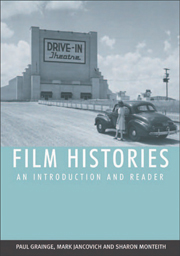Book contents
- Frontmatter
- Contents
- Preface
- Part I Film History from its Origins to 1945
- Part II Film History from 1946 to the Present
- 13 Postwar Challenges: National Regeneration, HUAC Investigations, Divestiture and Declining Audiences
- 14 The Politics of Polarisation: Affluence, Anxiety and the Cold War
- 15 Cinematic Spectacles and the Rise of the Independents
- 16 New Waves, Specialist Audiences and Adult Films
- 17 Radicalism, Revolution and Counter-Cinema
- 18 Modernism, Nostalgia and the Hollywood Renaissance
- 19 From Movie Brats to Movie Blockbusters
- 20 The Exhibitors Strike Back: Multiplexes, Video and the Rise of Home Cinema
- 21 Postmodernism, High Concept and Eighties Excess
- 22 Cults, Independents and ‘Guerrilla’ Filmmaking
- 23 From Cinemas to Theme Parks: Conglomeration, Synergy and Multimedia
- 24 Globalisation and the New Millennium
- Bibliography
- Copyright Acknowledgements
- Index
15 - Cinematic Spectacles and the Rise of the Independents
from Part II - Film History from 1946 to the Present
Published online by Cambridge University Press: 05 August 2013
- Frontmatter
- Contents
- Preface
- Part I Film History from its Origins to 1945
- Part II Film History from 1946 to the Present
- 13 Postwar Challenges: National Regeneration, HUAC Investigations, Divestiture and Declining Audiences
- 14 The Politics of Polarisation: Affluence, Anxiety and the Cold War
- 15 Cinematic Spectacles and the Rise of the Independents
- 16 New Waves, Specialist Audiences and Adult Films
- 17 Radicalism, Revolution and Counter-Cinema
- 18 Modernism, Nostalgia and the Hollywood Renaissance
- 19 From Movie Brats to Movie Blockbusters
- 20 The Exhibitors Strike Back: Multiplexes, Video and the Rise of Home Cinema
- 21 Postmodernism, High Concept and Eighties Excess
- 22 Cults, Independents and ‘Guerrilla’ Filmmaking
- 23 From Cinemas to Theme Parks: Conglomeration, Synergy and Multimedia
- 24 Globalisation and the New Millennium
- Bibliography
- Copyright Acknowledgements
- Index
Summary
The 1950s saw the breaking up of the studio system in the new age of television and a refining of the cinematic experience. Technologies that were pioneered in the 1920s, such as zoom lens and widescreen, found their niche in the cinema of the 1950s. It is not a coincidence that the 1950s is associated with a series of technological innovations in cinema. As television began to take off outside the studios' control, audiences for theatre-based entertainment declined. Hollywood made both bold and sometimes outlandish attempts to bring them back. By the end of the 1950s, widescreen entertainment had become entrenched as a Hollywood staple and film producers and exhibitors were even competing for the best way to pipe smells around an auditorium. In the meantime events like the Paramount decision of 1948 and resistance to having to qualify for the MPAA seal of approval for films with controversial content contributed to the rise of independent producers and directors.
In a decade in which leisure became a market, cinema was only one of a panoply of options for entertainment; driving and camping holidays, and home improvement, for example, provided a veritable democracy of consumption. The emphasis on families spending time together and the rise of the suburbs in the 1950s speaks to a general disinclination to travel downtown to the cinema on a regular basis.
- Type
- Chapter
- Information
- Film HistoriesAn Introduction and Reader, pp. 340 - 370Publisher: Edinburgh University PressPrint publication year: 2007



